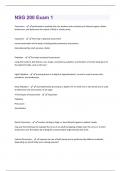NSG 200 Exam 1
Percussion - performed to evaluate the size, borders and consistency of internal organs; detect
tenderness, and determine the extent of fluid in a body cavity
Inspection - First step in physical assessment
visual examination of the body, including body movement and posture
data obtained by smell are also a factor
Palpation - 2nd step in physical assessment
using the hands to feel texture, size, shape, consistency, pulsation, and location of certain body parts of
the patient's body, such as the liver `
Light Palpation - pressing down to a depth of approximately 1 cm and is used to assess skin,
pulsations, and tenderness
Deep Palpation - accomplished by pressing to a depth of 4 cm with one or two hands and is used
to determine size and contour of an organ
4 Techniques of Assessment - Inspection
Palpation
Percussion
Auscultation
Direct Percussion - involves striking a finger or hand directly against a patient's body
may use this technique to evaluate the sinus of an adult by tapping a finger over the sinus or to elicit
tenderness over the kidney by striking the costovertebral angle directly with a fist
Indirect Percussion - requires the use of both hands and is performed by different methods,
depending on which body area is being assessed
,position of the other fingers of the nondominant hand is important; they are spread apart and slightly
elevated off the patient's skin so they do not dampen the vibration
Five Percussion Tones - 1. Resonant
2. Flat
3. Dull
4. Tympanic
5. Hyperresonant
Resonant - Percussion tone
heard over the lungs
loud intensity, low pitch, long duration, hollow quality
Flat - Percussion tone
heard over bones and muscle
soft intensity, high pitch, short duration, extremely dull quality
Dull - Percussion tone
Heard over viscera and liver borders
medium intensity, medium high pitch, medium duration, thudlike quality
Tympanic - Percussion tone
heard over the stomach and gas bubbles in intestines
loud intensity, high pitch, medium duration, drumlike quality
Hyperresonant - Percussion tone
heard when air is trapped in lunch (emphysema)
very loud intensity, very low pitch, longer duration, booming quality
,Ausculation - 4th step in the physical assessment
involves listening to sounds within the body
stethoscope is usually used
used when evaluating conditions of heart, blood vessels, lungs and intestines
listen for intensity, pitch, duration and qualtiy
SBAR - Situation
Background
Assessment
Recommendation
Active listening: SOLAR - Sit facing the client
Observe and open posture
Lean toward the patient
Establish eye contact
Relax
Use of touch
Standard Precautions - applies in all health care settings
hand hygiene, use of PPE, patient-care equipment
Diaphragm of stethescope - larger part of the stethoscope
used to listen to high-pitched sounds such as breath sounds, bowel sounds, and normal heart sounds
Bell of stethoscope - smaller part of stethoscope
used to listen to soft, low-pitched sounds such as extra heart sounds or vascular sounds (bruit)
Intensity - loudness of the sounds, described as soft, medium or loud
, Pitch - frequency or number of sound waves generated per second
high-pitched sounds have high frequencies
expected high-pitched sounds are breath sounds, whereas cardiac sounds are low pitched
Duration of sound vibrations - short, medium, or long
layers of soft tissue dampen the duration of sounds from deep organs
Quality - refers to the description of sounds (hollow, dull, crackle)
Supine - lying on the back, face up
assess head and neck, anterior thorax and lungs, breasts, axilla, heart, abdomen, extremities, pulses
Dorsal Recumbent - lying on back with legs bent and feet flat
assess head and neck, anterior thorax and lungs, breasts, axilla, heart and abdomen
used for abdominal assessment, promotes relaxation of abdominal muscles
lithotomy - Position used to assess female genitalia and genital tract
Sims position - the patient is lying on the left side with the right knee and thigh drawn up with the
left arm placed along the back
used to assess rectum and bagina
prone position - lying face down
used to assess musculoskeletal system
only used to assess the extension of the hip joint
Lateral recumbent - lying on the side




